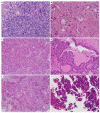Metastatic Tumors of the Sinonasal Cavity: A 15-Year Review of 17 Cases
- PMID: 31010194
- PMCID: PMC6517969
- DOI: 10.3390/jcm8040539
Metastatic Tumors of the Sinonasal Cavity: A 15-Year Review of 17 Cases
Abstract
Extranasal cancers that metastasize to the sinonasal cavity are very rare. To date, there are only limited reports regarding this rare condition within the literature. Therefore, we retrospectively reviewed all patients diagnosed with metastatic cancer of the sinonasal tract from 2003 to 2018 at a tertiary academic medical center. Patient demographic data, clinical presentation, treatment modalities, and outcomes were investigated. There were a total of 17 patients (9 males and 8 females) included in the analysis. The mean age was 56.8 years (range 27-80). The most common primary malignancies were hepatocellular carcinoma (n = 3) and gastrointestinal tract adenocarcinoma (n = 3). The most common site of metastasis was the nasal cavity (n = 8). Five patients received radical tumor resection and the others underwent radiotherapy, chemotherapy, or combined chemoradiotherapy. The 2-year survival was 28%. In summary, metastasis to the sinonasal cavity remains extremely rare. A high degree of suspicion regarding the possibility of metastatic spread to the sinonasal region is necessary for patients with a previous history of malignancy who present with new sinonasal symptoms. The treatment strategy of sinonasal metastatic cancer is usually palliative therapy and the prognosis remains poor. However, early detection and diagnosis, coupled with aggressive treatment, may improve patient quality of life.
Keywords: cancer; maxillary sinus; metastases; paranasal sinuses; sinonasal malignancy.
Conflict of interest statement
The authors declare no conflict of interest.
Figures




References
-
- Carrau R.L., Myers E.N. Neoplasms of the nose and paranasal sinuses. In: Bailey B.J., Calhoun K.H., Healy G.B., Johnson J.T., Jackler R.K., Pillsbury H.C. III, Tardy M.E., editors. Head and Neck Surgery-Otolaryngology. 3rd ed. Lippincott Williams & Wilkins; Philadelphia, PA, USA: 2001. pp. 1247–1264.

